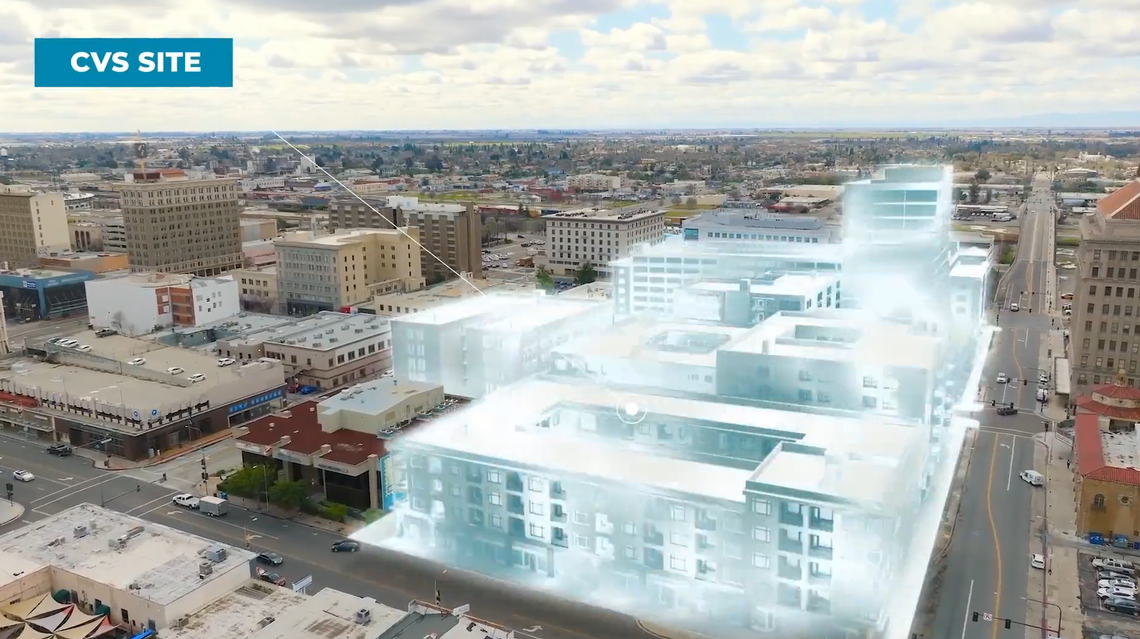Fresno wins another downtown improvement grant to spur housing. Here’s what’s planned
On the heels of a $250 million earmark in California’s state budgets for downtown Fresno infrastructure over the next three years, the city has landed another state grant of almost $44 million to drive the development of more downtown housing.
“These funds will serve as a catalyst to our revitalization efforts by accelerating housing in the downtown and Chinatown area,” Fresno Mayor Jerry Dyer said Monday as he announced the city’s plans for the grant. The money is coming from a special fund through the California Department of Housing and Community Development.
The awards were initially announced Friday by Gov. Gavin Newsom. Fresno is one of seven cities collectively receiving $239 million from the state under the Catalytic Infill Infrastructure Grant program. Dyer said it was his understanding that more than 50 cities had submitted applications.
The money will be used for capital and infrastructure improvements needed to spur future housing development in downtown neighborhoods.
“Our target area for this grant really is for immediacy of housing in the downtown area between Inyo and Tuolumne streets, from Van Ness Avenue to H Street; on the Chinatown side, it’s between F and G streets from Inyo to Fresno streets,” Dyer said. “That’s where we’re going to focus initially, (with) infrastructure, parking, streets, and green space” to prepare for developers to build a combination of affordable and market-rate housing.
Dyer said $14.3 million will be put toward the aging downtown water distribution system, while another $16.8 mllion will be for improvements to the sewer lines in the area. A new parking structure near the former CVS Pharmacy store at Fulton and Tuolumne streets is also planned, with about $11.7 million to be set aside for that garage.
Those improvements, Dyer said, are expected to help drive more than 860 new housing units in downtown and Chinatown. Those include:
Almost 470 units on the south side of Tuolumne Street between Fulton Street and Van Ness Avenue.
More than 290 at the location now occupied by a warehouse on H Street south of Inyo Street, near the Chukchansi Park baseball stadium.
About 71 units through refurbishing the old Bing Kong Association building on China Alley between Kern and Tulare streets in Chinatown.
About 85 units through refurbishing the Peacock Building on F Street between Kern and Tulare streets in Chinatown.

A new passenger station for California’s future high-speed rail system features prominently in a promotional video prepared by the city for its grant application. “Anchoring this vision of a vibrant downtown is the nation’s first high-speed rail station, set to open by 2030,” the video’s narrator states. “For Fresno, the possibilities of this station go beyond transportation, and will reconnect neighborhoods that were physically isolated from economic opportunity, like our historic Chinatown.”
In addition to the grant awarded to Fresno, other California cities receiving grants in the latest funding round include:
El Cerrito, $20 million to support transit-oriented development at the El Cerrito Plaza BART transit station.
Oakland, $40 million for site preparation work, utility improvements and other improvements for several housing sites.
San Diego, $45 million for site preparation including demolition, excavation and grading to support several planned housing developments.
San Francisco, $45 million for land acquisition for a new park, new bike lanes, pedestrian pathways and housing site work.
Santa Rosa, $9 million to demolish an existing parking garage and parking lots, as well as utility and infrastructure upgrades.
Los Angeles, $45 million for demolition of existing buildings and surface grading, streetscape and infrastructure improvements, and supporting 75 home-ownership units.
“With nearly a quarter of a billion-dollar investment, California is jump-starting the construction of new housing throughout the state,” Gov. Gavin Newsom said Friday in a grant announcement. “In a post pandemic world and as we strive to build more housing, California is using this opportunity to re-imagine the future of our cities – creating communities where people drive less and live closer to their jobs and kids’ schools.”
While the recent grant for Fresno is focused on a relatively small area of downtown and Chinatown, the larger $250 million in state funds announced earlier this year is geared toward water, sewer, parking and street infrastructure across the much broader downtown district – an area that already includes zoning for almost 75,000 residential housing units.
“Based on what we’ve seen and heard over the years, absent the infrastructure in place, it makes it too expensive for developers to build those units and ultimately pricing yourself out of the market,” Dyer said. “Housing will follow infrastructure, and retail, restaurants and entertainment will follow the housing.”
